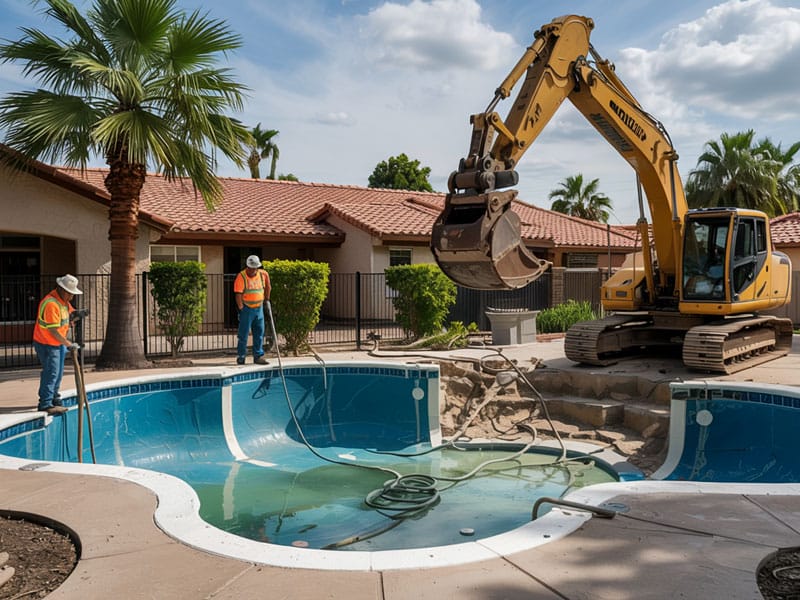
A Complete Guide to Pool Fill-In Costs for Phoenix, Mesa & Scottsdale
If you reside in Phoenix, Mesa, Scottsdale, or another nearby city and are considering pool removal, this guide is just right for you.
It will lay out the expenses involved.
Pool elimination can come at a hefty price tag.
Several key factors must be taken into account.
These are inclusive of your pool’s dimensions, and the choice of material also impacts cost – fiberglass or concrete.
Eliminating a pool necessitates draining it first, then addressing the cavity left behind.
Full pool elimination involves removing all materials and using fill material to avert compaction or sinkholes.
Labor costs are additional expenses to bear.
Don’t overlook additional costs, such as reviving the landscape after demolition.
Water conservation is another motivation for individuals to eliminate pools in desert regions.
Pool upkeep requires a significant amount of water, along with potential chemical usage, which affects both cost and the environment.
Safety installations, such as fences and covers, should be considered when opting for a new pool, as they are essential for ensuring child safety near water bodies.
Local guidelines differ on pool drainage due to potential risks of groundwater contamination during monsoon seasons; ensure to investigate these beforehand.
Lastly, although eliminating a swimming pool reduces water usage and maintenance costs, consider the impact it has on your property’s functionality and value before proceeding.
Key Takeaways
- The cost of filling a pool fluctuates depending on its size, type, and material.
- Job and permit charges have a substantial impact on the total expense.
- The selection of fill substances such as soil, gravel, or concrete affects the cost.
- The budget escalates with the restoration of the landscape and addressing possible sinkhole issues.
- Engaging a contractor who is knowledgeable about local regulations is crucial for effective expense management.
Factors That Affect Pool Fill-In Costs
Filling in your pool costs vary by its size, type, and material.
You will pay for demolition, drainage, labor, the use of heavy machinery, and permit fees.
Pool size and type
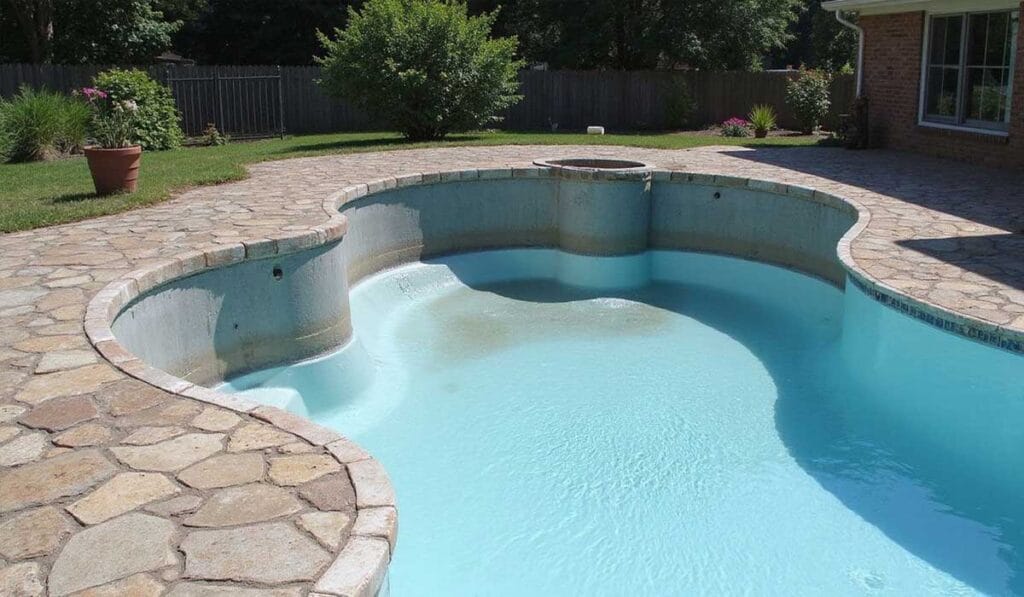
The size of your pool affects the cost to fill it in.
A larger lap pool costs more to fill in than a smaller plunge pool.
The type of pool you have also impacts the work needed for removal.
An inground pool is harder to remove than an above-ground one.
Fiberglass, vinyl, and concrete pools each present their unique removal challenges.
Draining and removing a concrete pool is tougher than dealing with a fiberglass one.
This decision affects the materials you will need for the job.
Pool material
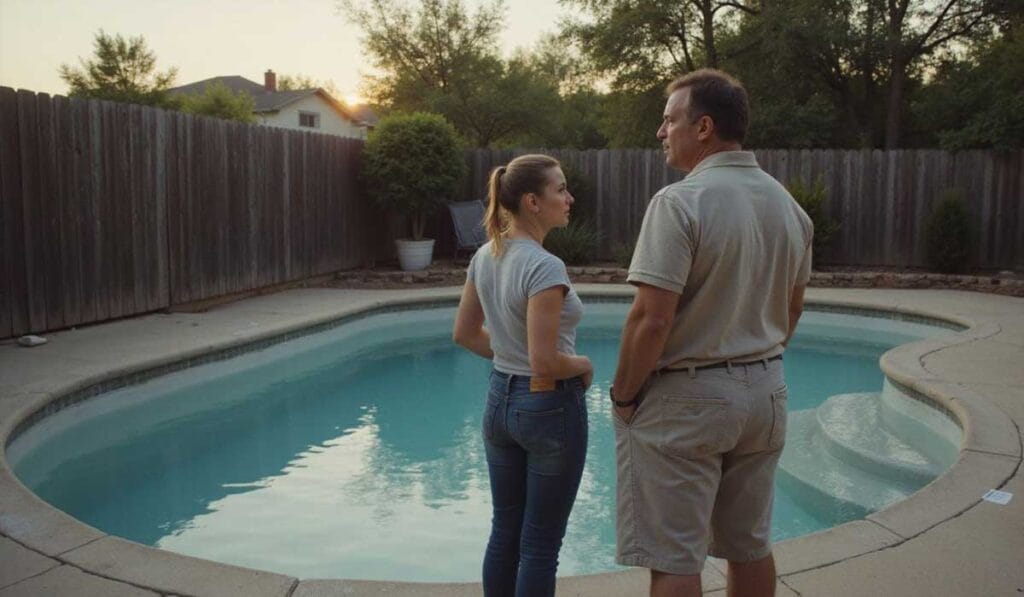
The material used for the pool affects your costs for filling it in and removing it.
Concrete pools are difficult to break down, resulting in higher labor costs.
Fiberglass pools are less expensive to remove since they are lighter.
Consider how materials influence future steps.
Local regulations may require specific actions based on the pool material, which can further affect costs.
Disposing of old pool parts also varies in price by material type, adding additional expenses if special preparation is needed due to the chosen material.
Type of fill material used
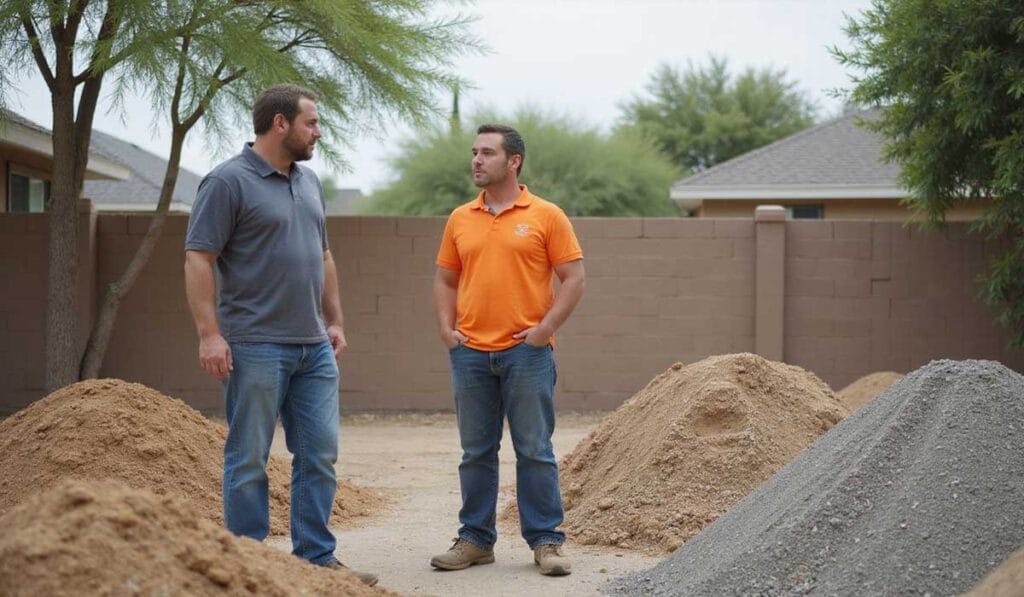
When removing a pool in Phoenix, Mesa, or Scottsdale, you need the right fill material.
Options include dirt, gravel, fill sand, topsoil, and concrete.
Each has its price and benefits.
The terrain near your home affects your choice.
Some materials settle more readily or are more readily available locally.
Choosing the right fill material can transform an old pool area into a great space for landscaping.
Material costs differ greatly.
Dirt may be less expensive, but it could require extra work to settle properly.
Concrete may have a higher initial cost, but it provides a stable base that is less likely to settle over time.
Consider these tips when picking materials to repurpose your old swimming area.
Pool draining and demolition costs
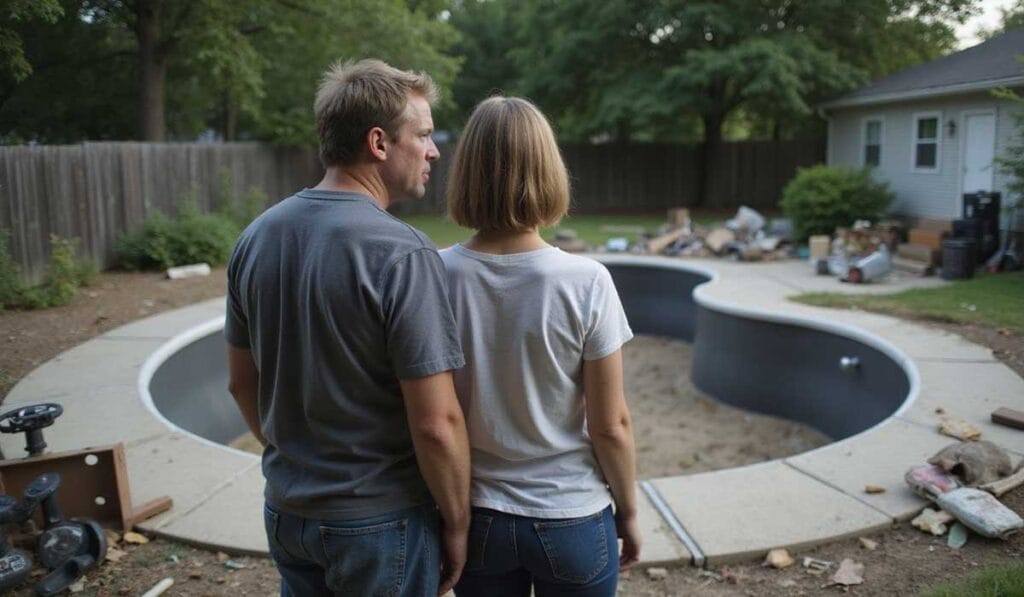
The process of taking out an inground pool includes emptying the water and disassembling the structure.
The final expense hinges on the pool’s dimensions and composition.
Concrete pools require a substantial amount of work and equipment compared to their fiberglass counterparts.
In areas such as Phoenix, Mesa, and Scottsdale, localized regulations can impact the total price.
Workforce and equipment come at a high cost.
The task of pool destruction requires experienced personnel to dismantle your pool carefully.
They also handle waste removal. Local rules or guidelines in Maricopa County may lead to increased expenses.
Labor and equipment expenses
When you decide to remove your pool, labor and machinery costs will be a large part of the expense.
The cost varies depending on the pool size and type.
For some jobs, workers might only need shovels, but for others, heavy equipment is necessary.
Installing this equipment in your backyard can also impact the price.
If access is difficult, more manual work is required, raising labor costs.
Keep in mind that in areas like Maricopa County—including Phoenix, Mesa, and Scottsdale—prices can differ due to local regulations and average wages.
Choose a pool removal contractor who clearly explains their labor and equipment requirements, as this impacts the cost you pay.
Permit and regulatory fees
Labor and equipment costs are the first to be considered when filling a pool in Maricopa County.
Then, permit and regulatory fees follow.
These fees ensure your pool fill-in meets safety and environmental rules.
You must get permission from the local government offices.
Maricopa County sets permit fees for plan checks and inspections.
This guarantees safety for everyone involved.
Always check the required permits before starting work to avoid delays or extra costs later.
Fees can change, so it’s best to ask early during your planning phase.
Knowing permit costs helps keep your project smooth without surprises.
Types of Fill Materials and Their Costs
Choosing the right stuff to fill in your old pool is like picking out ingredients for a recipe.
You’ve got dirt, pebbles, sand, good earth, and even broken-up cement.
Each one comes with its price tag.
So, let’s roll up our sleeves and take a look at how much these materials might cost you.
Dirt
The type of dirt matters when filling your pool.
In cities like Phoenix, Mesa, and Scottsdale, the cost of dirt varies by location.
Pick high-quality soil that packs well to prevent sinkholes.
The more soil you need for a big or deep pool, the higher the cost.
Proper soil choice protects your yard’s health and saves money.
Gravel
Gravel serves as a reliable material for filling pools.
It balances firmness and allows water to pass through, preventing your backyard from flooding after heavy rain.
This stability ensures the ground remains even over time.
While gravel costs more than dirt, it’s cheaper than concrete.
Planning is crucial for gravel delivery to ensure easy access for trucks and even distribution in your yard, although this may slightly increase the cost.
However, investing in gravel minimizes future issues with ground stability and drainage, eliminating unwanted puddles around the area where your pool used to be.
Fill sand
Fill sand is a smart pick for filling in your pool.
It’s affordable and easily accessible.
It also creates a strong base for any yard projects you’re planning.
Fill sand allows water to flow through quickly, preventing rainwater from gathering in the old pool space.
Homeowners favor fill sand for its ability to prevent pooling and runoff under lawns or gardens.
For a smooth and stable surface, ensure proper compaction during the job.
Topsoil
Switching from fill sand to topsoil is a key step after removing your pool.
Topsoil is the top layer that will impact how well plants grow in the former pool area.
Various types of topsoil exist, each with its own cost.
The price can vary based on your location, such as Phoenix, Mesa, or Scottsdale.
Choosing the right topsoil is crucial to prevent excessive ground settlement over time.
It should blend with your yard’s existing soil for stability and aesthetics.
This decision determines whether the filled area will become a thriving part of your garden again.
Concrete
Concrete is a durable choice for filling in pools.
It lasts longer but may cost more than other options, such as dirt or gravel.
The price varies based on the amount of concrete required and the labor involved in its installation.
Moving on to dirt, this material is another option for filling in pools.
Dirt is less expensive and widely available.
Additional Costs to Consider

Once your pool is filled, make sure to consider landscaping and possible sinkholes.
Also, consider the expenses associated with clearing debris from the old pool.
Landscaping after pool fill-in
After you fill your pool, consider transforming the space into a lawn or garden.
Costs for such projects vary in Mesa, Phoenix, and Scottsdale.
Landscaping your yard after removing the pool can be expensive, but it can turn your yard into a relaxing area.
Research plant and grass prices in Maricopa County before making a decision on your landscaping.
The cost will influence your decision.
New plants require care, including watering and, if necessary, adding soil amendments to promote healthy growth.
Addressing potential sinkholes
Filling in a pool might lead to sinkholes, creating problems in your yard.
To prevent this, experts should examine the soil and rocks beneath where your pool stood.
Certain soils require more care due to their nature.
Also, you must consider local regulations that guide these procedures.
Knowing about the ground conditions and rules helps avoid unexpected sinkholes after pool removal.
Waste and debris removal
Before filling in your pool, consider the removal of waste and debris.
This includes broken concrete and old pool equipment.
The cost can be high, especially in cities like Phoenix, Mesa, and Scottsdale, due to different local regulations.
Plan this early to avoid unexpected expenses.
Efficient debris removal is key for a quick and affordable pool fill-in process.
In Maricopa County, knowing what costs to expect helps you choose the right service.
Always check if cleanup costs are included in their quotes to prevent surprise charges later.
Choosing the Right Contractor
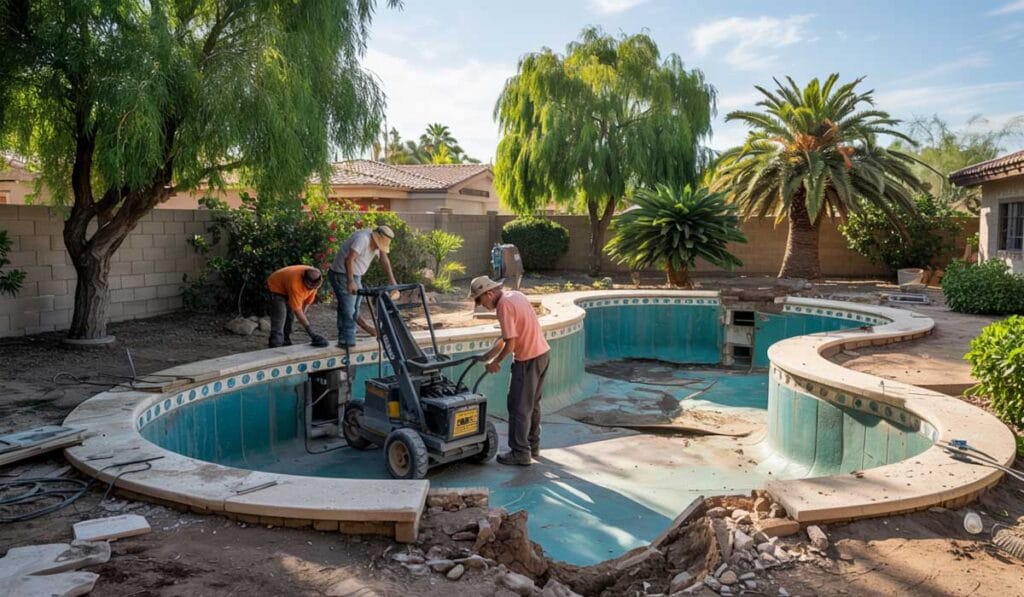
Choosing the right team for your pool removal involves finding a professional who can complete the job efficiently and affordably.
Our guide simplifies this process.
– Look for experienced professionals in full pool removal, including in-ground pools made of fiberglass, concrete, or vinyl.
Consider the costs of draining the pool, removing materials, and refilling it with suitable fill material.
– Factor in labor costs and possibly hiring a structural engineer to ensure foundation safety.
– Keep in mind local regulations and permits for pool demolition and landfill use for disposal.
– Understand how this project affects home insurance premiums and the usability of properties.
What to look for in a pool fill-in service
For filling in your pool, pick a team experienced with all types, including inground, fiberglass, and concrete pools.
They need to know the right materials and have the equipment for draining and demolition.
They should be familiar with the rules on permits and landfill restrictions for Phoenix, Mesa, and Scottsdale.
Please find out how they’ve tackled challenges like sinkholes or waste removal in past projects.
Their quote should cover all costs upfront, without any additional fees later.
Questions to ask your contractor
Find the right person to fill in your pool.
Choose someone with experience, reliability, and fair pricing.
Here’s what to consider:
- The cost of filling your pool should include a detailed expense breakdown.
- A contractor must have experience with inground pools made of fiberglass or concrete.
- The best fill material for Maricopa County will depend on local climate conditions.
- Check if you need a permit, and if the contractor is responsible for obtaining it.
- Ask how long the pool removal process will take.
- Good contractors can share references from previous jobs.
- Ensure the quote covers all costs, including labor and equipment use, without any hidden fees.
- The strategy to prevent sinkholes after filling your pool is crucial.
- Confirm that waste and debris removal are included in the service price.
- Consider landscaping services to revitalize your backyard.
Choose confidently based on clear, straightforward answers.
Conclusion
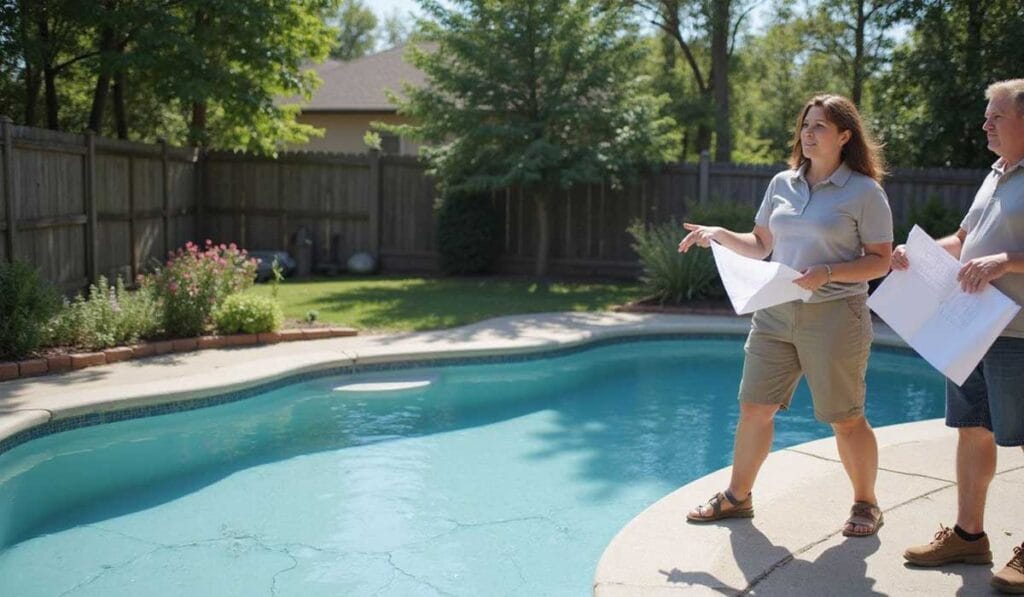
When planning to fill in a pool in Phoenix, Mesa, or Scottsdale, it’s essential to understand that the pool size, materials used, and permit fees all play significant roles in determining the cost.
Choosing between dirt and gravel will also affect your final expenses.
After demolishing your old pool, think about what you want for your backyard’s future.
If hiring professionals for the job, ask them detailed questions to ensure they meet your standards.
This knowledge prepares you to start this project while keeping costs manageable.
FAQs
1. How does pool size and type affect the cost of filling in a pool in Phoenix, Mesa & Scottsdale?
Pool size plays a big role in determining the cost of fill-in. Larger pools, such as lap pools or inground pools, will require more fill material, resulting in higher costs. The type of pool – be it fiberglass, concrete, or vinyl also impacts the price due to varying labor costs for draining and removal.
2. Can local regulations impact my pool fill-in project?
Absolutely! Local regulations, including safety rules from homeowner’s associations, can dictate certain requirements, such as hiring a structural engineer or implementing specific safety features like fences around your now-filled pool.
3. What’s the relationship between pool maintenance and filling in a swimming hole?
Well, if you’re tired of high maintenance costs related to chemical usage, heating systems for saltwater pools, or even regular lawn care around the area, opting for full pool demolition could save you some pretty pennies!
4. Are there any hidden costs I should consider when planning for the removal of my pool?
Yes indeed! Don’t forget about potential expenses related to restoring your backyard after pool demolition, which might include landscaping work or installing safety covers over the area where your water oasis once was.
5. Could weather conditions, such as the monsoon season, affect my budget?
You betcha! Monsoon season can make your backyard soggy, making it harder— and pricier —for workers to safely remove equipment and complete their tasks efficiently.
6. Is there any financial aid available to help with these costs?
Great question! You may find local rebates available that promote water conservation by removing private pools. Alternatively, personal loans from banks or lines of credit could offer support, depending on your credit score.
